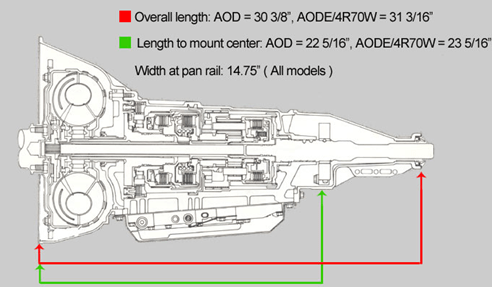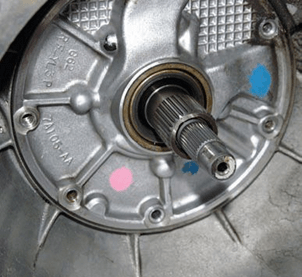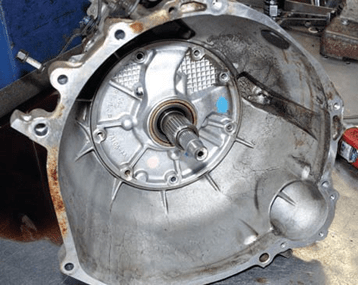AOD and 4R70W – Differences and Similarities – Pros vs Cons
Ford’s AOD evolved into a highly successful mechanically modulated transmission from its 1980 introduction until production ended in 1991. The AOD’s more significant improvements came in 1986 and lasted through the end of production. Ford developed the AODE and 4R70W to achieve cohesive engine and transmission function in 1991.

The AODE/4R70W is a 4-speed, rear-drive automatic overdrive with electronic control, hence the AODE designation. Ford went to electronic control not only for engine/transmission cohesion, but also improved shift quality by removing the short-comings of mechanical control. Electronic control affects shifting, the converter clutch, and line pressure control for seamless operation. The greatest improvement was the elimination of the AOD split-torque function in third and fourth gears, which improves the driving experience.
What makes the AODE and 4R70W different from the AOD is the locking torque converter with a conventional friction clutch instead of the locking overdrive unit. The AODE/4R70W rotating mass is similar to that of the AOD. The AODE/4R70W front pump is high-efficiency aluminum rather than iron.

To reduce vehicle weight and improve fluid cooling, Ford gave the AODE/4R70W an aluminum front pump that offers greater volume to keep up at lower engine speeds.

The AODE/ 4R70W differs from the AOD in input. The AOD has dual input shafts (inner and outer); the AODE/4R70W has one, which splines into the forward clutch.
Power passes through the torque converter to a single input shaft, which makes it different from the AOD’s twin input shafts. In final drive, however, power passes through the unit differently. Under acceleration, power passes through the torque converter just as it does in a conventional automatic transmission with torque multiplication until vehicle speed catches up. Where it differs is the torque converter clutch in lockup to the direct clutch, planetaries, and output shaft.
More than 30 years into its service life, the AOD has proven to be an outstanding transmission for street and strip use thanks to effective engineering refinements. Vintage Ford enthusiasts love the AOD for its simplicity, durability, and an array of installation kits available in the aftermarket.
The AOD is a true hydromechanical 4-speed automatic transmission controlled by a manual shifter and throttle valve (TV) cable. The TV cable, tied to the vehicle’s throttle linkage, works like a kickdown linkage, yet it is more finite in its execution because it does the work of both a kickdown (downshift) linkage and vacuum modulator used on earlier Ford automatics. There is no vacuum modulator or kickdown linkage with the AOD as we see with the older C3, C4, C6, and FMX transmissions; only the lone TV cable.
The easiest way to identify the AOD is the “Automatic Overdrive Metric” wording along with the Ford Blue Oval stamped into its 14-bolt galvanized steel pan. The AOD, like the C6, is a one-piece casting that includes bellhousing and main case, which makes the AOD different from the C3, C4, and FMX transmissions with separate bolt-on bellhousings. Instead of a conventional rotary backup light/neutral safety switch at the manual shift linkage as seen with older Ford automatics, the AOD has a screw-in multi-pin linear connector backup light/neutral safety switch on the left-hand side above the manual shift and TV cable linkage.
The real beauty of the AOD transmission is its easy fitment into just about any Ford application. Thanks to the perseverance of the aftermarket, it has become easy to swap the AOD into a vintage Ford, Mercury, or Lincoln with a variety of installation kits, which makes the AOD an excellent choice for any classic car project. If you already have an AOD in your late-model Ford, you understand this transmission’s benefits in terms of smooth operation and improved fuel efficiency. Key to getting along with the AOD is learning as much as possible about its function and how to properly execute a successful rebuild and tune.
Aside from the benefit of over-drive in the AOD, the other benefit is direct drive from the torque converter shell to the overdrive unit. What makes this different from most automatic overdrives is where lockup takes place: inside the overdrive unit instead of the torque converter via an inner input shaft. This feature offers non-slip direct drive in fourth gear (overdrive) and to some degree in third gear as well.
To improve durability and make engine and transmission function more cohesive, Ford introduced the AODE in 1991. AODE, or AOD Electronic Control, delivers precision operation thanks to more unified engine and transmission electronic control. No TV cable adjustment, just predictable computer-controlled operation based on factory calibration, vehicle speed, and throttle position. The AODE was originally conceived for a new generation of overhead-cam Modular V-8s that first arrived in the 1991 Lincoln Town Car. The AODE was also installed behind the 5.0L and 5.8L Ford pushrod V-8s beginning in 1991. The AODE’s gearing gave these pushrod small-blocks extra snap under acceleration.
AOD TRANSMISSION PROS:
- More cost effective than 4R70W Transmission
- Fits most any Small Block Ford – Mustangs, Falcons, Fairlanes with minimal Modifications.
- Similar in fitment / size to the older C4. Shifter Location.
- Has 4th Gear Overdrive. Reduces RPMs by approx. 30% less than the C4 for better fuel efficiency.
- When built properly can handle up to 500 HP.
- Cross member location similar location to the early C4s with some minor modifications
GEARING:
- 1st: 2.40:1
- 2nd 1.47:1
- 3rd: 1.00:1
- OD .67:1
AOD TRANSMISSION CONS:
- Needs Manual adjustment of TV Cable where the 4R70W Shifts electronically. If not adjusted properly can burn out the clutches being the transmission does not know when to upshift or Downshift transmission
- No Provision to lock out Torque Converter
- Handles up to 450HP unless heavily modified. After investing a lot of upgrades may be better at that point to go with a 4R70W.
- Need taller gears to get the vehicle off the line than a C4 For example. 373-4.11s usually work well.
4R70W TRANSMISSIONS PROS:
- More acceleration off throttle than the AOD with 1st Gear
- No TV Cable uses Computer to control shift points
- Can handle naturally up to 500 HP with Mods 650+HP
- Has provision lock out Torque Converter
- Bigger Overdrive Band
GEARING:
- 1st: 2.48:1
- 2nd 1.55:1
- 3rd: 1.00:1
- OD .70:1
4R70W TRANSMISSION CONS:
- Slightly Longer than the AOD Transmission, requiring a different Driveshaft length, angle and Cross Member. The aftermarket has solutions for this.
- The Cost is more than a AOD – Mostly for the electronics
- Takes some more time to setup the electronics – but worth it in the long run.
Fordcobraengines.com by TD Performance offers Complete Engine & Transmission Pkgs

